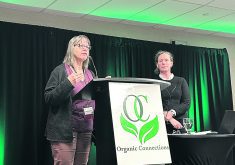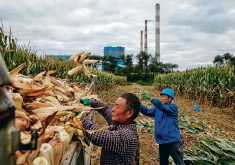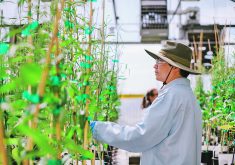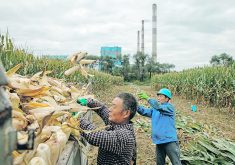Scientists describe incident as ‘bizarre’ as they try to figure out how wheat plants showed up in an Alberta ditch
It appears the public will never know how Monsanto’s Roundup Ready trait ended up in wheat plants discovered in Alberta 17 years after the company shut down field trials of the MON71200 GM trait.
“All evidence-based lines of inquiry were pursued and have not resulted in any further avenues to be explored,” said the agency.
Read Also

Farming Smarter receives financial boost from Alberta government for potato research
Farming Smarter near Lethbridge got a boost to its research equipment, thanks to the Alberta government’s increase in funding for research associations.
“Going forward, the CFIA will focus on monitoring the site and will verify that all GM wheat that may germinate is destroyed.”
Many people in the grain industry are trying to figure out what may have happened, including former Monsanto researcher Curtis Rempel, who was involved with the development of Roundup Ready wheat.
One theory is pollen flow but the nearest research facility was located 300 kilometres away from where the GM wheat volunteers were discovered and he said it is near impossible for that to happen.
Another theory is that the seeds made the 300 kilometre journey in the belly of a bird and then were pooped out at the discovery site.
“From what I gather wheat doesn’t survive the passage of digestive tracts very well,” said Rempel.
Even if pollen drift somehow occurred or the seed was transported to the site by bird or truck it still doesn’t add up, he said.
If successful pollination occurred or the seeds grew into plants and propagated for 17 years there would be more GM wheat plants than the small amount discovered at the site.
Rempel also noted that the Roundup Ready wheat they were working with in the trials was less vigorous than check varieties and would have had difficulty outcompeting other crops in the area for 17 years.
And what about the theory that the seed survived in the soil until it emerged 17 years later? He said research shows wheat seed isn’t viable in the seed bank for much beyond three to five months. Three years is the absolute limit.
So, what’s the conclusion?
“It doesn’t appear that it’s an act of nature,” said Rempel.
“It seems bizarre to me.”
Retired Agriculture Canada wheat breeder Ron DePauw also used the word “bizarre” to describe the Alberta discovery.
He said there are all kinds of hypotheses of how Monsanto’s trait ended up in an Alberta field.
“I’ve got lots of them but I don’t think it serves any good purpose to do speculation,” said DePauw.
He does not find it unusual that the trait ended up in a different kind of wheat than the one that was field tested because the company probably inserted the trait in all kinds of experimental lines in the lab before choosing one for field testing.
What is confusing is how seed from one of those lab plants could have escaped the highly controlled research environment and end up in a field 17 years later.
“It’s really a huge puzzle. How would something like that get out like that?” said DePauw.
Two of the three cases of volunteer GM wheat discovered in the United States also left regulators scratching their heads.
In the 2013 case of Roundup Ready wheat discovered in a field in Oregon, the United States Department of Agriculture’s Animal and Plant Health Inspection Service (APHIS) came to a similar conclusion about the source of contamination as the CFIA did about the Alberta incident.
“After exhausting all leads, APHIS was unable to determine exactly how the GE wheat came to grow in the farmer’s field,” it said in a news release.
Monsanto floated its own theory at that time, saying the evidence was consistent with sabotage. The company said the GM wheat was found distributed evenly in patches throughout the Oregon field, the “pattern you would expect” of someone dispersing the seeds.
“It is fair to say there are folks who don’t like biotechnology and would use this to create problems,” Robb Fraley, Monsanto’s chief technology officer said in an Associated Press story at that time.
The 2014 case of Roundup Ready wheat found in Montana was considerably different because it was discovered at a research facility where GM wheat had previously been grown.
The Roundup Ready wheat volunteers were discovered growing at Montana State University’s Southern Agricultural Research Center where Monsanto had conducted GM wheat trials between 2000 and 2003.
In that case, APHIS found that Monsanto and the university failed to adhere to required standards for field trials and issued warning letters to both.
The final case of Roundup Ready GM wheat found in a farmer’s field in Washington state was more in line with the cases in Oregon and Alberta.
“APHIS was unable to determine how the 22 wheat plants that were volunteering in an unplanted field came to be,” the agency said in an email to The Western Producer.
The CFIA said there is no evidence linking the Canadian case to the U.S. cases because the Alberta GM wheat is genetically different from the three lines found in the U.S.


















